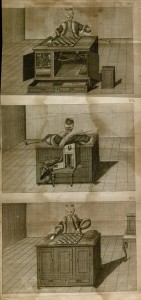
The Mechanical Turk.
Windisch, Karl Gottlieb. Inanimate Reason, 1784.
Houghton Library, Harvard University. SG 3675.94.10
Source: John Overholt.
In a recent article for the BBC News, Adam Gopnik reflects on the persistent allure of the Turk, a chess-playing automaton that fascinated eighteenth-century spectators across Europe and America. The Turk was created by Viennese inventor Wolfgang von Kempelen and first appeared in the court of Empress Maria Theresa. Essentially an early type of robot, the contraption featured a large wooden cabinet with a chessboard on top behind which sat the torso of a mustached man dressed in oriental robes. Before every performance, in order to convince the audience that the Turk really was a machine, the operator, first Kempelen and then later Johann Maelzel, would go through an elaborate demonstration of opening the cabinet doors to reveal the complex, whirring jumble of wheels and cogs that powered the machine. Once the cabinet was closed, an audience member would be invited to challenge the Turk at a game of chess. Impressively, the Turk was able not only to move its own chess pieces but also to recognize if its opponent made an illegal move and even to win a large portion of the games it played. The automaton was a sensation. Before being destroyed by a fire in New York in the 1850s, it toured throughout Europe and North America and played against such opponents as Benjamin Franklin and Napoleon Bonaparte. Most impressive, though, is the secret that the Turk managed to keep for over 50 years: it was all a fraud.
In reality, the Turk’s impressive chess skills were the result not of elaborate, mechanical clockwork but of a human operator, usually a random chess-player from the town where it was currently performing, cleverly hidden in a secret compartment behind the display of clockwork parts. It is this ability to fool its eighteenth-century audience for so long, or rather the willingness of the eighteenth-century audience to be fooled by the automaton, that Gopnik focuses on in his article. Although there were several people who doubted the machine early on – Edgar Allen Poe, for example, discusses how it must be controlled by a hidden chess player in his essay “Maelzel’s Chess-Player” – the majority of spectators were happily convinced that it was just an impressive piece of machinery. Gopnik argues that the spectators who were so willing to believe the lie did so because they wanted what we still want to this day: a beautiful, elegant solution (an extraordinary automaton) rather than a cynical, ugly one (a hidden chess-player). Gopnik also points out that the real genius of the machine’s inventor was not fooling his audience but realizing and harnessing the mastery that is available in the modern world but that often goes unnoticed. The chess-players who ran the machine were not chess-masters, but they were good enough to beat the majority of people they played against.
Fascination for the Turk isn’t limited to the eighteenth century, though. Several scholars in both the humanities and the sciences have studied and written about the Turk and other popular automata of the eighteenth century, including Gerald Levitt’s book The Turk, Chess Automaton, that gives detailed analysis of the machine’s hidden operation as well as the literature written about it. Likewise, Julie Park discusses the connection between general automata and the novel in the eighteenth century as part of a consumer-driven desire for novelty and self-representation in her book The Self and It: Novel Objects in Eighteenth Century England. In his book The Turk: The Life and Times of the Famous Eighteenth-Century Chess-Playing Machine, Tom Standage discusses how this mysterious machine played an important role not only in the development of the power loom and the computer but even in current debates about machine and artificial intelligence. The fact that it was fairly recently reconstructed by John Gaughan, though it no longer requires a hidden human operator, speaks to its lasting appeal to and effect on modern society. Interestingly, and as if to support Gopnik’s argument for realizing the world’s untapped potential for mastery, Amazon has launched an online crowdsourcing service that helps computer programmers connect and collaborate in order to accomplish a variety of tasks that computers still can’t do. They named the service, which they categorize as “artificial artificial intelligence,” The Mechanical Turk, after the eighteenth-century fraud automaton that was actually man-powered.

Pingback: "The Mechanical Turk" and Automata of...